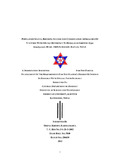Please use this identifier to cite or link to this item:
https://elibrary.tucl.edu.np/handle/123456789/3558| Title: | Population Status Breeding Success and Conservation Approaches of Vultures with Special Reference to Himalayan Griffon (Gyps Himalayensis HUME, 1969) in Khodpe, Baitadi, Nepal |
| Authors: | Karmacharya, Dikpal Krishna |
| Keywords: | Breeding success;Himalayan Griffon Vulture;Population size |
| Issue Date: | 2011 |
| Publisher: | Central Department of Zoology |
| Institute Name: | Central Department of Zoology |
| Level: | Masters |
| Abstract: | Study of population status and breeding success of Himalayan Griffon (Gyps himalayensis) was conducted in far western mid hills of Khodpe, Baitadi, Nepal from January 2010 to May 2010. The study was mainly focused on the cliffs with vulture nests near Siddheshwor Temple and also emphasized on the other potential cliffs near Siddhadeep School, Harichan Mod and Ranga Jujuna of Baitadi. Using Jacknife technique the estimated population size of Vultures in study area was found to be 20 individuals for 2010 field season. Among them HGs were estimated to be 12. Other Vulture species include Egyptian Vulture (Neophron percnopterus) and Lammergeier (Gypaetus barbatus). Altogether 11 occupied nests of HGs were recorded in the cliff near Siddheshwor Temple. Among them 4 were active nests (having eggs) and only 3 nests were productive (fledged chicks). Based on active nests as primary unit the breeding success was found to be 75% while based on occupied nest as primary unit the breeding success was found to be 27% for 2010 field season at Khodpe, Baitadi. Since, 2cal was found to be smaller than 2tab, the null hypothesis was accepted at 5% level of significance and it can be concluded that there was no significant difference in the flock size of Vultures in different months at Khodpe, Baitadi in 2010 field season. 60 % of 63 local respondents in the area bury their livestock carcass for the sanitation purpose and only 17.5% people throw away which could lead to poor availability of food for the Vultures. Due to misconception of Vultures being taken as eagles, these birds are hunted in the area. No veterinary Diclofenac was recorded in agrovet outlets due to the ban of its production and import in Nepal instead only Meloxicam was recorded for sale. Destruction of large cliffs and forests for road construction resulting loss of habitat, excessive use of poisons and pesticides in the agriculture and the climatic change are the possible threats of these birds in the study area. In total, 96 local people were awared about their significance and the conservation messages. This study is the pioneer approach in this area so continuation of the study and establishment of vulture conservation projects are highly recommended which could prove as a boon for conservation of declining vultures. Key words: Baitadi, Breeding success, Himalayan Griffon Vulture, NSAID, Population size, Meloxicam. Veterinary Diclofenac |
| URI: | http://elibrary.tucl.edu.np/handle/123456789/3558 |
| Appears in Collections: | Zoology |
Files in This Item:
| File | Description | Size | Format | |
|---|---|---|---|---|
| Full Thesis.pdf | 999.04 kB | Adobe PDF |  View/Open |
Items in DSpace are protected by copyright, with all rights reserved, unless otherwise indicated.
